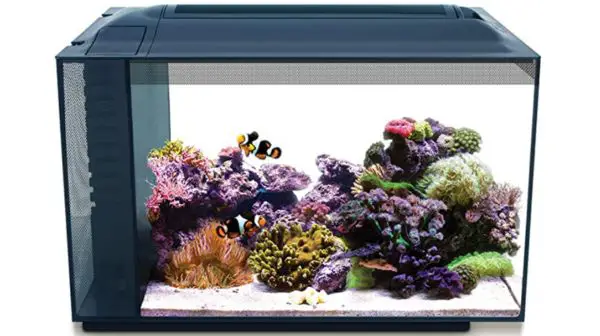Clownfish are fascinating little fish, and perfect for people at any level of fishkeeping. People gravitate towards Clownfish due to their unique coloration and awesome patterns, as well as being incredibly hardy and pretty easy to look after when compared with most tropical fish. They are also usually model citizens of any marine fish community and certainly brighten up most aquariums.
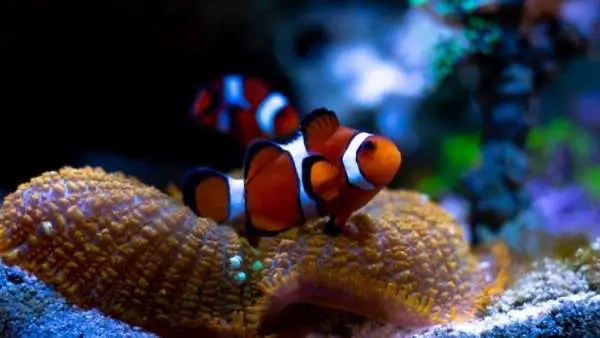
The main considerations before purchasing any Clownfish are the same as most other fish - tank setup. Ensuring the water parameters, saltwater temperature, salinity, and pH levels are all correct for your Clownfish is of the utmost importance.
Typically, when you acquire new fish you need to first cycle the non-reef or reef tank correctly to meet your fish's demands, and the same goes with Clownfish. So, assuming you have completed the nitrogen cycle for your saltwater aquarium, we now need to consider your Clownfish tank setup.
How Do You Need to Setup a Clownfish Tank?
First of all, Clownfish are saltwater fish, meaning that they must be put in a saltwater tank to survive. I know it seems obvious, but you would be surprised! If you put a Clownfish in a freshwater fish tank, it will die.
Something else many people forget or perhaps overlook is the fact that there are many different species of Clownfish, not just the one you see in Finding Nemo! The different types of Clownfish range in size and behavior, with the most common two species being the True Percula Clownfish and the Ocellaris Clownfish, these two species look very similar but are different in a number of different ways.
If you would rather watch a video summarizing how to set up a clownfish tank, why not check out mine below:
Ideal Clownfish Tank Size
Typically, in the wild, clownfish will not venture too far from their home, which is usually a sea anemone in a shallow coral reef. When in an aquarium environment they tend to swim up and down more often, but they still rarely travel long distances.
Nonetheless, a clownfish will certainly need a modest-sized fish tank, so avoid a tiny tank when conducting your clownfish tank setup just because they are not particularly mobile salwtater fish.
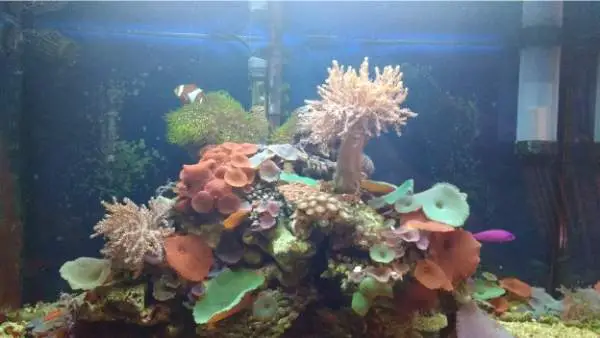
How Many Gallons Does a Clownfish Need
Clownfish need at least a 10-gallon tank so they have enough room to hide and do a little exploring, however, a 20-gallon tank can be more suitable.
To give you some inspiration, we have provided an ideal clownfish tank that is not only good quality, but the perfect size for keeping one of these vibrant fish.
Check out the perfect clownfish tank with all the information needed below:
- This 13.5 gallon (51.1 liter) aquarium is absolutely perfect for housing a clownfish. It is good quality with a clean glass honeycomb appearance, including a rear aquarium filter compartment and aquarium water line.
- A slick and modern design, ideal for keeping any location within your household, and this beautiful aquarium also comes with a powerful 3 stage filtration system with a mechanical, chemical, and biological filter media.
- It also comes with a brilliant LED aquarium light that adapts to both day and night. Additionally, the official dimensions of this aquarium are 22" L x 11.5" W x 15" H (56 cm x 29 cm x 38 cm), the wattage is 16 W, and the lumens is 1383 lm.
Most tank owners prefer to give Clownfish a minimum of a 30-gallon tank (113 liters), especially if you want to keep an Anemone too. However, 10 is absolutely fine, but you must know that for each additional Clownfish you might want to add, increase the tank size by a further 10 gallons.
Despite popular belief, larger tanks are much easier to look after than smaller ones.
Water parameters are much harder to measure and sustain in smaller tanks, not to mention they are much more difficult to clean than larger tanks. So, when it comes to tank sizes, if you are considering creating a reef tank environment, 30 gallons or more is the size that works best for Clownfish.
What Type of Tank Do Clownfish Need?
When it comes to the ideal Clownfish tank setup, an acrylic tank is highly recommended. They are typically more clear than standard glass tanks, and they usually come with LED lighting.
If for whatever reason your acrylic tank does not come with an LED light, then we suggest acquiring your own as the light will really bring out the beautiful array of colors displayed by the Clownfish.
Setting Up A Saltwater Clownfish Tank
Fortunately, Clownfish do not need a tank filled with different structures and ornament. However, if you do have a tank with decorations and live rock, that is also fine as it mimics most Clownfish's natural environment.
Clownfish and Anemones have a unique and well-documented relationship. Whilst Clownfish do not need them to survive, they certainly appreciate them, or at least having some spots around the tank to hide. However, after some time you will probably want to try out owning a Sea Anemone, but whilst being a beginner, it is all about taking small and methodical steps in becoming a brilliant hobbyist by looking after your fish correctly first.
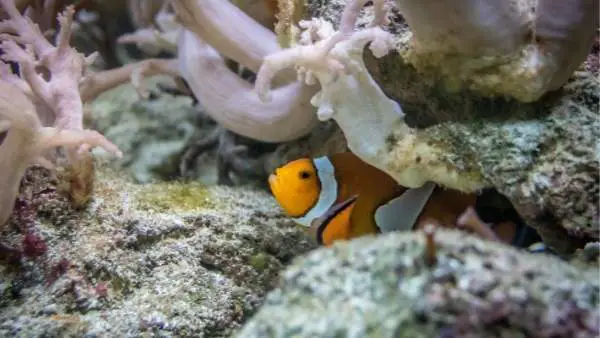
In setting up your tank for a Clownfish there are many hiding spaces that you can and need to create by yourself, clownfish need hiding spots not just to hide in, but to sleep in! You can create hiding spots by using rock and other decorations. Small cave features are readily available online too, which are great if you do not have the time to create your own hiding spots.
Water Parameters for a Clownfish Tank Setup
The water you must use for your Clownfish's saltwater aquarium setup is premium aquarium salt mix - this is incredibly important. Another recommendation is to purchase a salinity meter too, this way you can constantly measure the saltwater quality in your tank.
The specific gravity should range between 1.021 and 1.026, which is 29 to 35 PPT - these numbers will be indicated on your salinity meter. With regards to the pH level, you want your marine aquarium to range between 8.0 and 8.4, no more, no less.
For the best tank setup, you need to ensure the temperature is perfect for your Clownfish. The best water temperature for your Clownfish should be anywhere between 73℉ and 80℉ (22.8°C - 27°C). Also, the water flow in your tank should be moderate, ideally, you want enough water flow to provide a current, but you certainly don't want too much of a current that could potentially overwhelm the fish.
Clownfish Tank Setup - Tank Mates
A lot of people new to the hobby often overlook tank mates and compatibility when they purchase a new and exciting tropical marine fish. This is a mistake and can often lead to some pretty terrible situations for your fish community. It is so important to research correctly the type of fish species that can live with your Clownfish, ensuring a happy and stable environment.
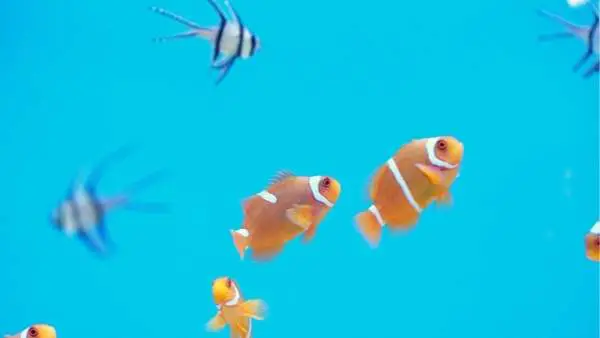
If you are brand new to fishkeeping and are looking to start an aquarium based on your Clownfish, it is advisable to keep your Clownfish alone for a few months while you get used to your new hobby, and then look into introducing some compatible tank mates when you have found your feet.
However, if you are not new and are looking to create an environment with many different fish, Clownfish tank mates such as Blennies, Angelfish, and Wrasses are great options. If you want a more in-depth summary of the best Clownfish tank mates, be sure to give our article on this a read. Additionally, the breeding process for pregnant clownfish is complex yet extremely rewarding - there is nothing more satisfying than creating a family of clownfish!
What Food Do Clownfish Need?
Fortunately, Clownfish are pretty easy to feed as they are far from picky and will eat most saltwater fish food, mostly flaked and pellets. It is important your Clownfish is on a varied and balanced diet, so providing Mysis Shrimp and Brine Shrimp for some meals is a great idea.
You should feed your Clownfish no more than once a day, and it is even suggested to miss a day of feeding perhaps once every other week or so.
It is crucial that, like with any fish, you do not overfeed your Clownfish. It is incredibly easy to do, but it must be avoided. You want to see absolutely no evidence of food in your tank after you have comprehensively fed your tank, and if you do, simply stop feeding them as much. It is more than important to understand the significance of overfeeding your fish, and why it must be avoided.
So, for anyone looking to purchase a Clownfish as a new addition to an already established non-reef or reef aquarium, or even build an aquarium around Clownfish as a beginner, following these tank setup advices will ensure your fish live a long and happy life and will teach you the basic skills needed to advance within the hobby.
Clownfish Tank Setup - Free Downloadable PDF
Now, we know that using an article as a reference can be a little tedious, especially when you have to sift through an entire page just to find the information you need, for example, the correct temperature for your clownfish.
So, we have created a fun and free downloadable PDF for you to use as a reference, either digitally, or printed. The PDF below contains all the main pieces of information provided in this article, we hope you find it useful.

